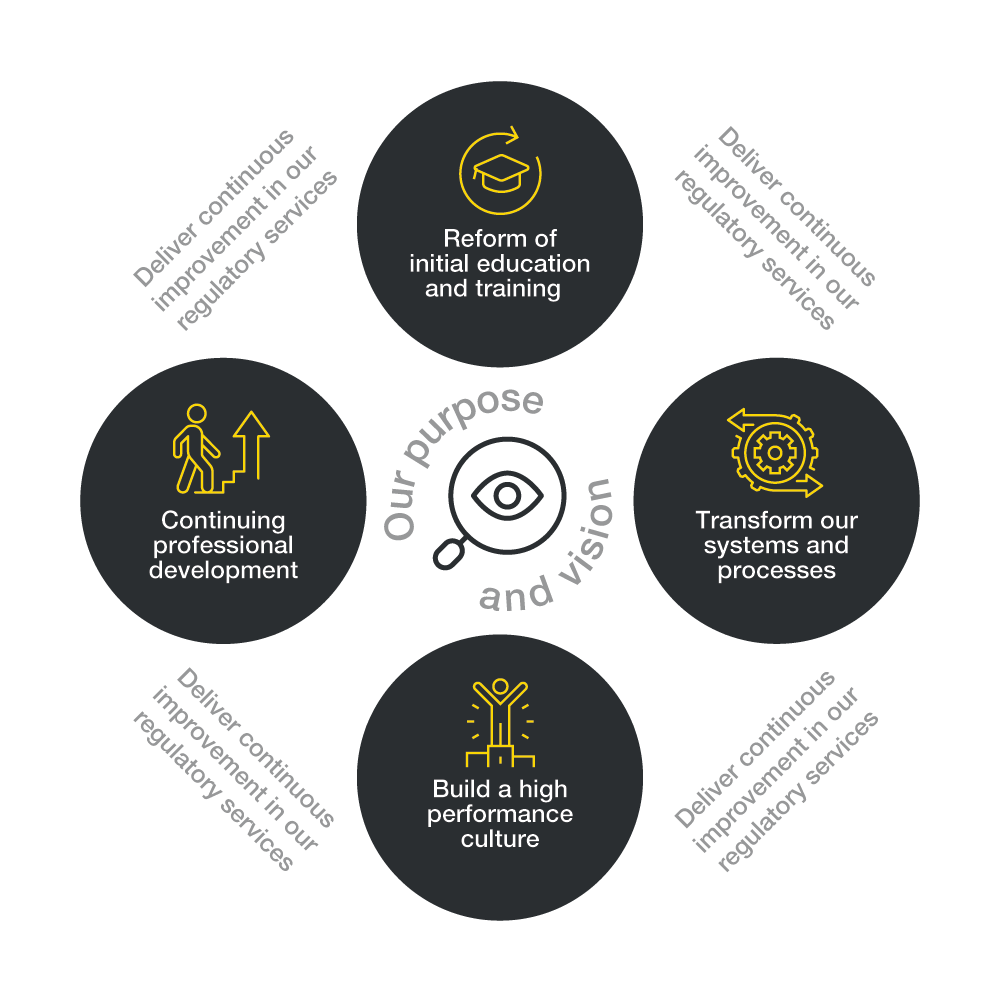Corporate Strategy 2022-2026
Contents
- Contents
- Chair and Chief Executive’s foreword
- About this strategy
- Our purpose, our vision, our approach
- Our strategic priorities
- Modernising initial education and training of architects
- Delivering a new system of continuing professional development for architects
- Transforming our systems, processes and information technology
- Investing in our people and building a positive and inclusive culture based on shared values and behaviours
- Download PDF version
Chair and Chief Executive’s foreword

Architects play a crucial role in creating a built environment that is safe, sustainable and where everyone in society can live well.
Foreword
Architects play a crucial role in creating a built environment that is safe, sustainable and where everyone in society can live well. There are many challenges to achieving those goals.
We know from the tragic events at Grenfell that there is much to be done to truly embed a culture of safety not just in architecture but across all the professions and organisations involved in building and construction. We know from overwhelming evidence the acute challenge society faces in relation to the climate emergency and the need to embed sustainability in all that we do. We recognise the significant challenges faced by society in relation to public health, and the importance of a built environment that supports healthy communities. A strong and vibrant architects profession is essential for cultural, economic and social reasons.
This strategy sets out how the Architects Registration Board (ARB) will respond to these and other challenges. We are determined to be bold and ambitious in recognising that we have a central role in areas such as the initial education and training of architects. We need to improve the way we work with the sector and the profession if we are to build a regulatory model which makes a positive contribution and helps the profession to maximise its potential. And we need to invest in and improve our core regulatory functions if we are to maintain the confidence of the public and the profession of architects in how we deliver our statutory duties.
There are many other bodies and organisations who have similarly vital roles – government, professional leadership bodies, policy makers, employers, education providers and others. We, as the regulator, must show leadership and rise to meet these challenges, protecting the public by helping to create an environment where the architects profession is as good as it can be, and truly delivers for society.
Find out how to stay in touch with us at arb.org.uk/talk-to-us

Alan Kershaw Chair

Hugh Simpson Chief Executive & Registrar
About this strategy
The ARB is an independent professional regulator, established by Parliament as a statutory body, through the Architects Act, in 1997.
We are accountable to government.

Our strategy sets out the outcomes we wish to achieve from our work so that the public and profession can hold us to account for delivery

The law gives us a number of core functions:
- To ensure only those who are suitably competent are allowed to practise as architects. We do this by approving the architecture qualifications required to join the Register of architects.
- We maintain a publicly available Register of architects so anyone using the services of an architect can be confident that they are suitably qualified and are fit to practise.
- We set the standards of conduct and practice the profession must meet and take action when any architect falls below the required standards of conduct or competence.
- We protect the legally restricted title ‘architect’.
But the functions listed above don’t explain our broader purpose – the difference we think regulation of architects can make if done well.
This strategy explains the purpose of regulation, our vision for ARB and the regulation of architecture over the next five years, our priority themes and the bold actions we will pursue to get there.
Importantly, it sets out the outcomes we wish to achieve from our work so that the public and profession can hold us to account for delivery.
Our purpose,
our vision,
our approach

We want a world in which the built environment inspires those who live and work in it, reflects the needs of society so that people are safe and can live well, and helps to tackle the fundamental challenges our planet faces.
Our purpose
Unless we are clear about the purpose for which we operate, we cannot be sure that what we do is providing a service to society. In short, regulation needs to be for a purpose beyond the sum of our statutory functions.
We want a world in which the built environment inspires those who live and work in it, reflects the needs of society so that people are safe and can live well, and helps to tackle the fundamental challenges our planet faces.
The contribution that regulation can make to this overarching purpose may be small, but we recognise that architects and other professionals in the built environment can achieve their own goals, potential and outcomes only if we are delivering effective regulation.
Our vision
We have an ambitious vision for ARB. Our goal is to deliver improvements and tangible outcomes in each of our core statutory functions and deliver meaningful and positive change in our strategic priorities.
Our vision and commitment is to:
- Demonstrate leadership for the sector in responding to key challenges including safety and climate change;
- Foster a culture of equality, diversity and inclusion in our own organisation and take action to ensure change occurs in architecture;
- Work with the profession (including employers, educators, students and others) to modernise initial education and training;
- Build on the professionalism of architects, implementing a new model of continuing professional development which supports and encourages good practice and lifelong learning;
- Embed a culture of continuous improvement within ARB so that our regulatory services are accessible, designed around the needs of architects and consumers, and are effective.
Our approach
We have set out our purpose and vision for ARB, but equally important to delivering successful regulation is being clear about how we will work.
We are committed to delivering regulation which adheres to the high-level principles of good regulation: proportionality, accountability, consistency, transparency and targeting.
Within that framework we see a number of principles which we believe must guide our work over the next five years if we are to deliver regulation in architecture effectively.
We want a world in which the built environment inspires those who live and work in it, reflects the needs of society so that people are safe and can live well, and helps to tackle the fundamental challenges our planet faces.
The contribution that regulation can make to this overarching purpose may be small, but we recognise that architects and other professionals in the built environment can achieve their own goals, potential and outcomes only if we are delivering effective regulation.
Open and engaging
ARB is a small organisation. To be effective it is critical that we are open and engaging with the public, with the profession and with all those with an interest in high quality architecture and the built environment. We recognise that levels of confidence in ARB have fluctuated since we were established in 1997 and it is our responsibility to be transparent, engage continuously to learn from others, and work collaboratively with the UK professional leadership bodies and other professions in the built environment.
Evidence-based
Our strategy sets out a bold and radical approach to delivering professional regulation. We have listened to architects, architectural practices, employers and others who have passionately told us change is needed, particularly in education and training. Where fresh thinking is required, so too is a proper evidence base. We will draw on the best available research as we develop policy. Where evidence is limited, we will engage directly with the sector to understand what works best.
Promoting diversity
We know that the profession is deeply unrepresentative of the society we serve. Although there have been some improvements in the diversity of trainees training to become architects, the gap is still unacceptable. ARB needs to do more than just shine a light; we need to take positive action to help bring about change. This action needs to be reflected in standards for institutions; in our review of the Code of Conduct and Practice for architects; in our own systems, processes and recruitment policies. We have a leadership role also to play, recognising that while ARB must take action, we can also ensure we work with other stakeholders to encourage change across the sector.
Responsive
We will be clear about the outcomes we are seeking to achieve through our work, responsive to feedback and willing to reflect and change our approach and methods if the evidence tells us we should.
Our strategic priorities
Our strategic priorities have been developed as part of our response to the major challenges facing society in general and the built environment in particular.
We have carried out engagement with the sector, reviewed and considered the research we have commissioned, conducted listening events with ARB’s Architects Engagement Group and worked collaboratively with the professional leadership bodies representing architecture and the other built environment professions.
Continuous improvement in our regulatory services
Over the next five years we need to modernise and transform the way in which ARB operates if architects and the public are to benefit from regulation.
Our vision is that during the period of the five year corporate strategy we will deliver the following changes:
Registration: our systems will mean architects can access registrant services online 24/7. They will be able to control their own data, removing the requirement for ARB staff to manually update more than 20,000 addresses each year. We will enable the public to access information so that they can easily check the registration status of architects and make decisions about who to employ.
Accreditation: alongside our review of initial education and training we will deliver improvements to the way we accredit or ‘prescribe’ qualifications. Schools of architecture will have improved information and guidance on requirements, and we will move away from the current bureaucratic paper based model of assurance to a more proportionate and blended approach, informed by risk assessment and including visits to institutions. We will also be data-driven, open and public about verifiable information we hold on institutions, including equality and diversity data.
Examination and international routes: we will overhaul the prescribed examination, ensuring it is proportionate and focused on the fitness to practise of architects, moving away from the current inefficient mapping process which provides unnecessary barriers for international architects. We will secure Mutual Recognition Agreements with competent authorities in other jurisdictions to ensure we are enabling the international exchange of ideas and free movement of architects in a way which continues to protect the public. We will also test these priority areas against our requirement to review any potential biases in our systems and promote equality and diversity.
Standards and good practice: we will review our core code of conduct and guidance by working with architects and the public to ensure all registrants understand their professional obligations and that we are providing guidance in those areas where support is needed.
Protection of title: by working with consumer organisations and other representative bodies we will raise awareness among the public of the importance of using only registered architects.
ARB Strategy


It is fundamental to the role of professional regulation that we work with the sector to set clear requirements for the outcomes of initial education and training, which in turn assure the public that all those on the Register of architects are competent to practise.
Modernise initial education and training of architects
Develop and deliver a new model of CPD
Transform our systems, processes and technology
Invest in our people
Our vision for 2026
Initial education and training of architects will better reflect the knowledge, skills, experience and behaviours they need in areas such as climate change, safety and emerging technologies. The structure of education and training will be reviewed to improve diversity and access to the profession, consider how and when specialism is needed and deliver effective and attractive pre-registration work experience.
Modernising initial education and training of architects
Our collective challenge
UK architectural education and training has a justifiable reputation for excellence globally, with UK courses in high demand from UK trainees and international trainees. However, the pace of change in society, and demands on the profession, are growing. We have seen rapid changes in the use of technology, the need to build a better safety culture across the sector, and an increasingly important role for architects, working with other professions, in tackling climate change and supporting biodiversity.
It is fundamental to the role of professional regulation that we work with the sector to set clear requirements for the outcomes of initial education and training, which in turn assure the public that all those on the Register of architects are competent to practise. We want to work with higher education institutions to ensure the learning outcomes we set and the standards we require of institutions support our shared goal of promoting quality in the education and training provided to students. We also know from research and from feedback that the current three-part structure of initial education and training in architecture is too rigid, costly and provides unnecessary barriers to diversity.
What ARB will do
- We will work with the sector to develop new learning outcomes for initial education and training of architects to replace the current ARB Criteria;
- We will set new standards for institutions to underpin these new learning outcomes and provide much greater clarity about how to meet our requirements, including our expectations around equality, diversity and inclusion;
- We will overhaul our prescription processes and introduce new quality assurance mechanisms which are proportionate, assure the public and support institutions to deliver high quality education and training;
- We will engage the sector to reform the structure of education and training, moving away from the current complexity which inhibits diversity, stifles innovation and erects barriers, particularly to aspiring architects from other fields and architects who qualified outside the UK;
- We will develop new international routes to registration by establishing agreements with global partners which are based on open and transparent principles, and review our prescribed examination.
Our vision for 2026
Architects will be utilising a continuing professional development (CPD) model they see as a positive contribution to their practice and professional development. There will be evidence that the model has made an impact on the competence of architects with learning shared across the profession.
Delivering a new system of continuing professional development for architects
Our collective challenge
A common feature of all regulated professions is the commitment to continuing professional development. The single greatest challenge is to develop a model which is robust and assures the public but which also is genuinely developmental and helps the profession. At their best, CPD schemes are a proportionate and effective way of supporting a culture of continuous improvement; at their worst, they instil a tick box mentality and are designed ineffectively as a mechanism for identifying unacceptable practice.
What ARB will do
- We will publish, following consultation and engagement, the key principles underpinning our work to develop a mandatory CPD system;
- We will work with the profession and the professional leadership bodies across the UK to build and implement a new model of CPD based on the key principles;
- We will develop a risk- based and proportionate assessment system for reviewing registrants’ CPD;
- We will invest in technology to make the process of submitting records simple and efficient;
- We will generate data and insight at an aggregate level to share with the sector and spread good practice.
Our vision for 2026
ARB’s systems and processes will enable architects to manage their own data and information, saving both time and money. The public will have increased transparency about qualified and registered architects. The IT infrastructure will not only ensure secure data but will generate insight into the profession, including areas where regulatory attention is needed such as equality and diversity, new guidance or changes to education and training.
Transforming our systems, processes and information technology
Our collective challenge
Operating remotely during the pandemic has demonstrated that ARB’s technology is not adequate for a new operating model where staff are required to work flexibly and where architects, higher education institutions and stakeholders need to be able to access our services and engage with us remotely.
ARB is a small organisation but requires robust and effective infrastructure to operate effectively and securely. There has been historic under-investment which needs rectifying to ensure our systems remain secure, that we can continue to manage the Register of architects, and prepare for future changes, including the implementation of a new model of CPD.
We also need to be able to better access, interrogate and analyse the data from the Register to generate insight for the sector about the changing makeup of the profession, as well as insights into quality and risk.
What ARB will do
- We will overhaul our systems and processes, so we move rapidly to a ‘self-serve’ model for registrants who need to update their data and information we hold;
- We will invest in our core information technology infrastructure to continue to protect the security and integrity of registrant data and deliver our statutory functions in a more efficient way;
- We will introduce cloud- based services and procure new software to manage the registration database;
- We will build our capacity and capability around data and insight.
Our vision for 2026
Like most organisations, the Covid-19 global pandemic has reminded us that the people who work for and with ARB are the most important factor in delivering our corporate strategy and our business plan. Our vision is for ARB to be an organisation where all our staff and our associates understand and are highly motivated to deliver our purpose and vision, where staff are well led and well managed, have the right skills and competencies, and are working to a shared set of values and behaviours. If we achieve this, we will deliver high quality regulation.
Investing in our people and building a positive and inclusive culture based on shared values and behaviours
Our collective challenge
Our corporate strategy sets out some bold ambitions for ARB. To deliver these we will invest in our staff to ensure that they are well led and have the right skills to deliver our corporate strategy.
Effective working both within teams and with stakeholders has been negatively affected by the global pandemic. While we have been able to utilise video conference technology, we also know that information sharing, personal development and collective working has suffered.
We know we can and must improve as an employer so that we equip our workforce to be flexible, to adapt to changes happening in the sector and to do so consistently with our organisational values. We have made a commitment to tackling the lack of diversity in architecture and we must also ensure we are promoting diversity within ARB, within our staff groups, our board and our associates.
What ARB will do
- With our staff, we will co-create the organisational values and underpinning behaviours for everyone who works at ARB;
- We will build a new flexible operating model so that we can continue to attract and retain staff in a post-Covid market;
- We will develop a new performance framework so that staff are highly motivated and clear on what success looks like;
- We will invest in staff training and development, particularly identifying new skills required in the organisation and gaps in knowledge;
- We will put equality, diversity and inclusion at the heart of all we do, with specific measurable goals, and report on our achievements.
